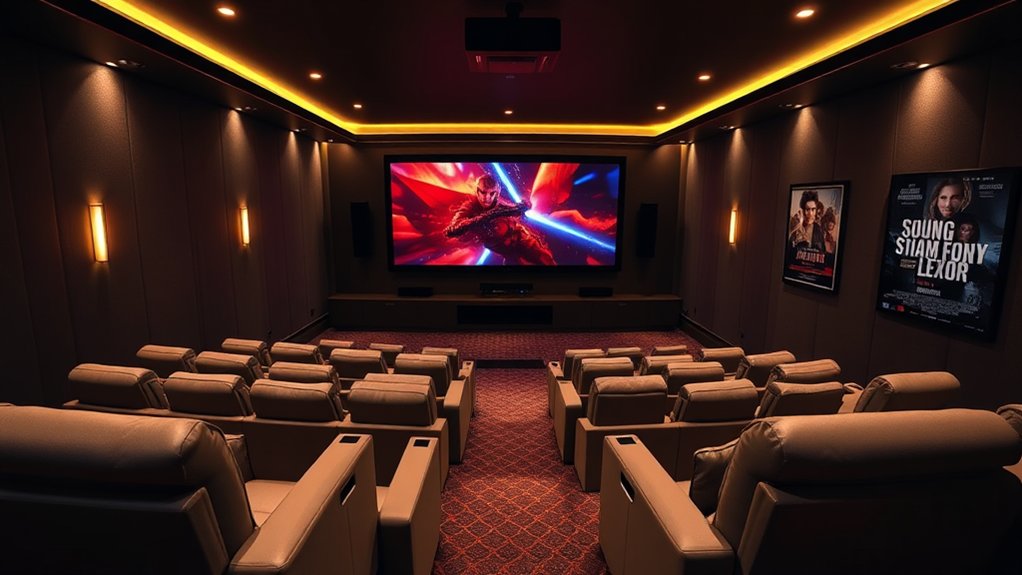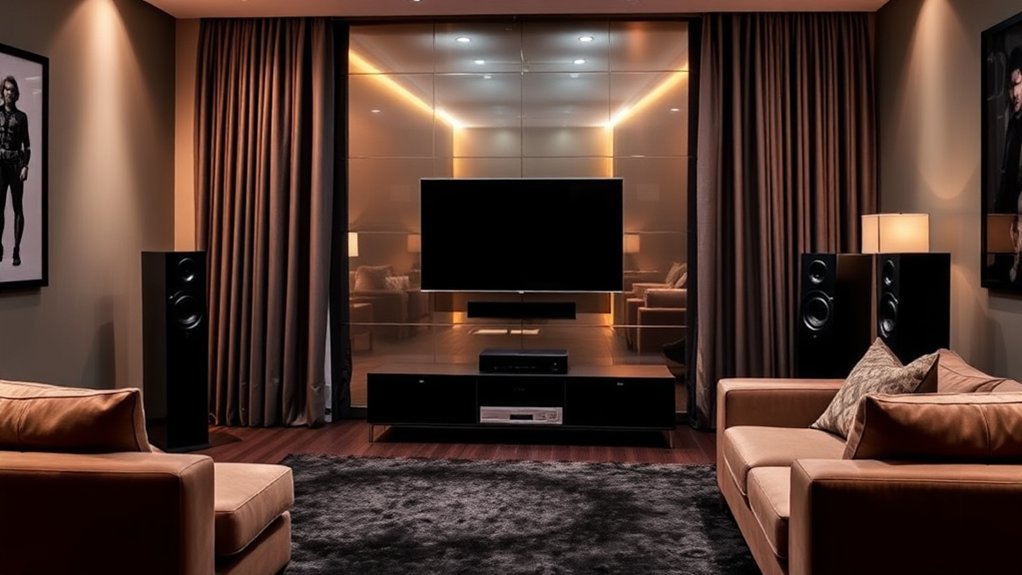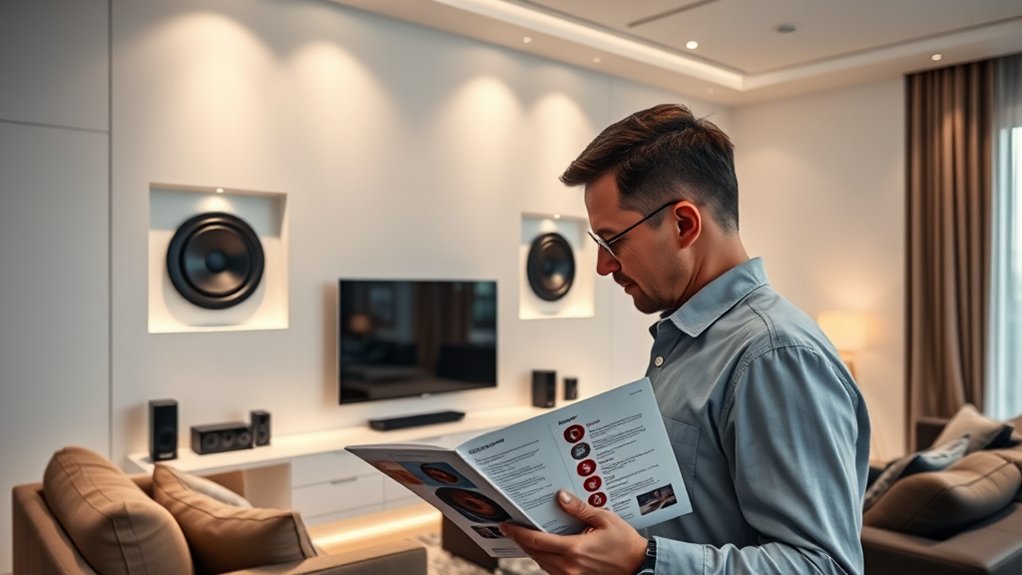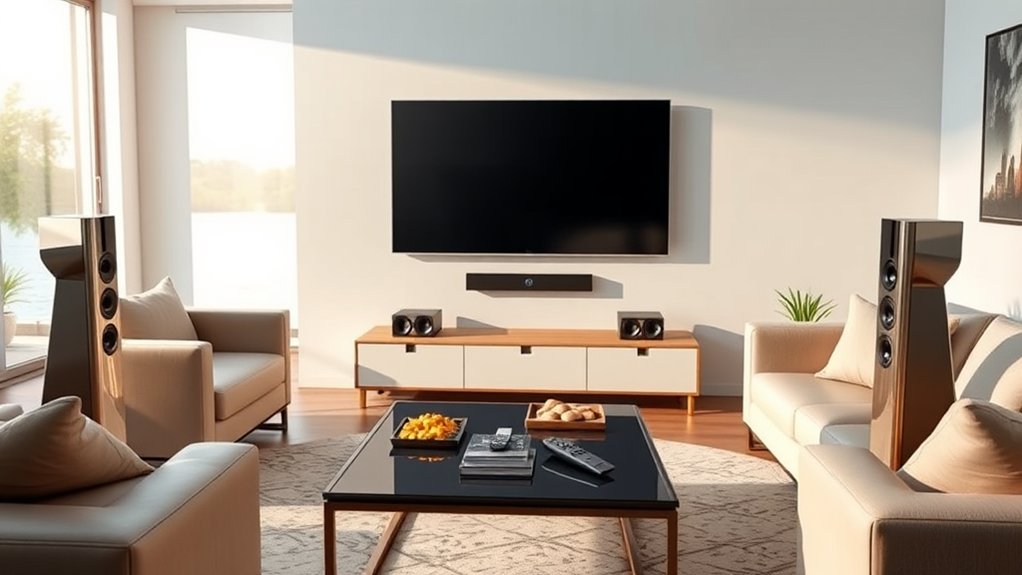When you’re choosing a top-rated 7.1 home theater, start by evaluating your audio needs and room size—ideal setups thrive in spaces around 24 ft by 15 ft. Prioritize true 7.1 surround sound for immersive experiences and consider advanced features like Dolby Atmos. Decide between wired and wireless systems based on sound quality preferences, and check brand reputation through customer reviews. Don’t overlook calibration tools for optimized audio output, and keep an eye on your budget for long-term value. Curious about how to boost your home theater game even further?
Key Highlights
- Consider room size and acoustics to optimize speaker placement for immersive sound experiences in your home theater setup.
- Select a true 7.1 channel system with a reliable reputation and advanced audio features like Dolby Atmos for superior sound quality.
- Assess whether a wireless or wired system fits your needs, weighing convenience against potential sound quality improvements in wired setups.
- Look for calibration tools that help adjust audio settings effectively without professional assistance, ensuring optimal performance.
- Plan your budget for quality equipment and consider gradual upgrades to balance performance and long-term value in your home theater.
Assess Your Audio Needs and Room Size
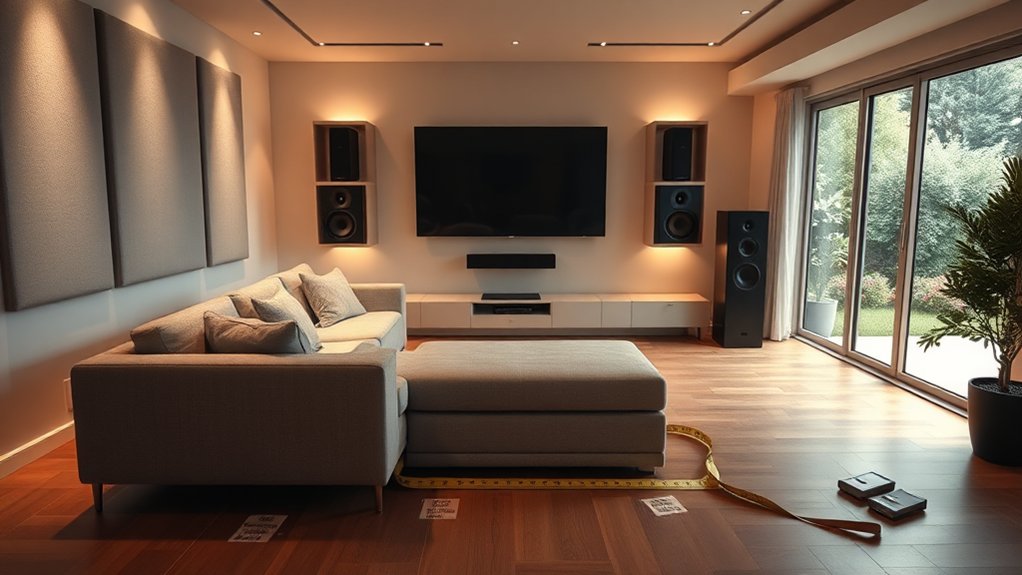
How do you create a home theater that not only meets your expectations but also improves your viewing experience?
First, assess your room size—ideally, you want about 24 ft by 15 ft with a 9 ft ceiling for that immersive feel. Remember, adhering to the golden ratio when planning dimensions can greatly enhance your audio experience.
Consider a spacious room of about 24 ft by 15 ft with a 9 ft ceiling to create that captivating theater experience.
Think about speaker placement; larger rooms give you the freedom to position speakers for best sound distribution, whereas smaller spaces might require some creative adjustments. Subwoofer behavior at power limits is also essential to consider, ensuring that your low frequencies remain clear even at higher volumes.
Ever crammed into a corner seat with no view? Avoid that by staggering your seating in rows, ensuring everyone gets a good line of sight.
Pay attention to acoustics, too; balancing sound reflections can make all the difference.
Furthermore, isn’t it better to feel the bass rumble? Your ears will thank you!
Prioritize True 7.1 Channel Surround Sound
Though some might think a simple soundbar is enough for an impressive home theater experience, nothing quite compares to the immersive thrill of a True 7.1 channel surround sound system. This setup, featuring seven speakers and a subwoofer, surrounds you with sound, making you feel like you’re right in the action.
During the regular 5.1 systems combine channels, a 7.1 system separates the rear and side effects, providing precise audio cues that improve your viewing experience. Imagine watching a movie where explosions come from behind you, not just the front! Additionally, the inclusion of a 10” subwoofer enhances the system’s ability to reproduce ultra-low frequencies, adding depth to your audio experience. The Polk Audio 5.1 Channel Home Theater System, for instance, incorporates a subwoofer that can deliver 100 watts dynamic power without distortion. Proper speaker placement and room size are crucial for maximizing its benefits, but once you experience that enveloping sound, you’ll wonder how you ever settled for less. To further elevate the audio experience, consider minimizing sound reflections to enhance audio quality in your setup.
Look for Advanced Audio Features
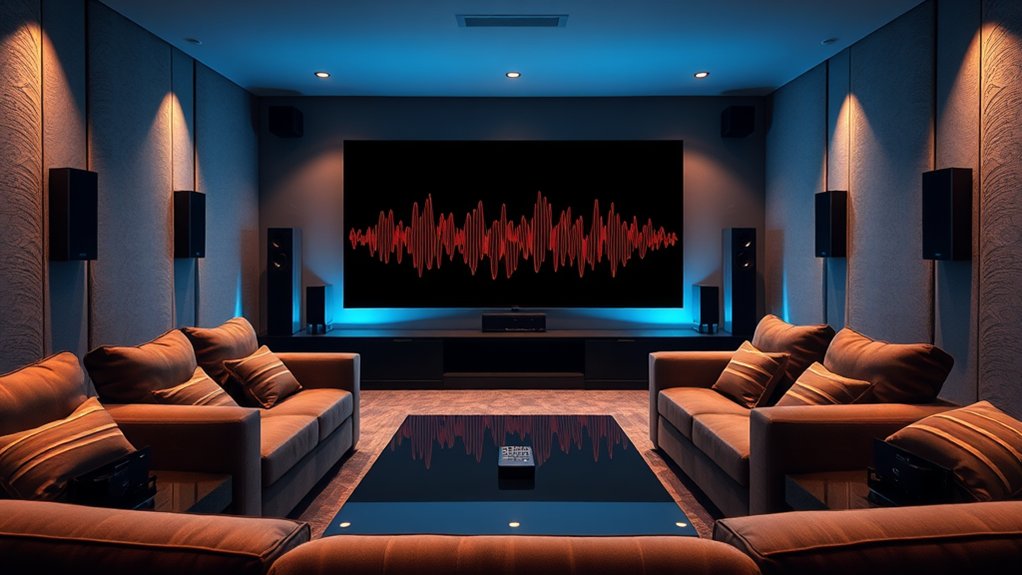
Regarding elevating your home theater experience, you’re going to want to pay close attention to advanced audio features that can truly make or break your enjoyment.
Imagine hearing raindrops above your head or feeling explosions surround you—thanks to formats like Dolby Atmos and DTS:X, that’s possible! These technologies turn your living room into a three-dimensional sound paradise, adapting to your speaker layout for a personalized experience. Notably, the Klipsch Reference R625 FA 5.1 Home Theater Pack includes built-in elevation channel speakers that enhance this immersive experience.
Don’t overlook the importance of high-resolution audio formats, either; they bring out the details that standard formats often miss.
Plus, systems with room correction technologies can analyze your space and fine-tune audio output, ensuring your setup sounds amazing regardless of its quirks.
Sounds tempting, right?
Evaluate Wireless vs. Wired Systems
Once you’ve appreciated the impact of advanced audio features on your home theater experience, shifting your focus to how you set up your system becomes just as important.
You might wonder if wireless or wired systems suit your needs better. Wireless systems simplify installation, meaning no cables are running through your walls, which is a major plus if you’re in a rental.
Nevertheless, wired systems deliver superior sound quality with zero latency—great for gaming or intense movie nights. Plus, they’re less likely to suffer from interference.
Of course, a wired setup might require some neat cable management and harder installation, so weigh the clean look of wireless against the steadfast performance of wired options. Sonos Beam is an excellent example of a compact wireless system that balances performance and space efficiency.
Which trade-off fits your lifestyle?
Investigate Brand Reputation and Reviews
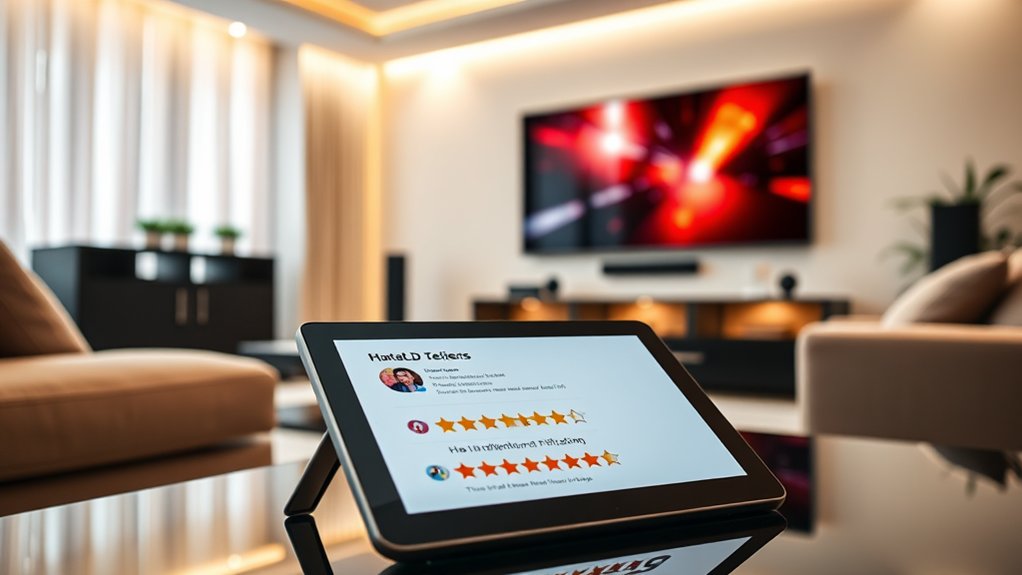
When you’re diving into the world of home theaters, understanding brand reputation and customer reviews can make all the difference in choosing the right system for you. A strong brand often signals consistent quality, reliability, and even better customer support.
After all, who wants to deal with faulty equipment right after their big purchase? Check out customer ratings; high averages usually indicate satisfactory user experiences. Look for patterns in reviews—endurance and sound quality are key. Additionally, consider systems that support Dolby Atmos and DTS:X as they significantly enhance the audio experience.
Don’t forget expert reviews either; they measure performance in optimized settings, helping you identify the best options. Keeping an eye on social media can provide insights into each brand’s responsiveness.
Consider Future-Proofing With HDMI Support
As you think about investing in a home theater system that’ll stand the test of time, it’s crucial not to overlook the importance of HDMI support, particularly HDMI 2.1 technology.
This cutting-edge standard supports higher resolutions and refresh rates, enabling compatibility with future displays that may make your current setup feel ancient—unless you want that.
Furthermore, HDMI 2.1 allows for improved audio formats like Dolby Atmos, ensuring immersive sound experiences.
HDMI 2.1 enhances audio formats such as Dolby Atmos, delivering an unparalleled immersive sound experience.
It even boasts gaming features like variable refresh rates, making it ideal for next-gen consoles.
By future-proofing your system with these advanced capabilities, you’ll save yourself from costly upgrades down the road, keeping your home theater relevant and enjoyable for years to come. Additionally, HDMI 2.1 technology includes features like enhanced Audio Return Channel, which further elevates your audio experience.
Why settle for less?
Check for Built-in Calibration Tools
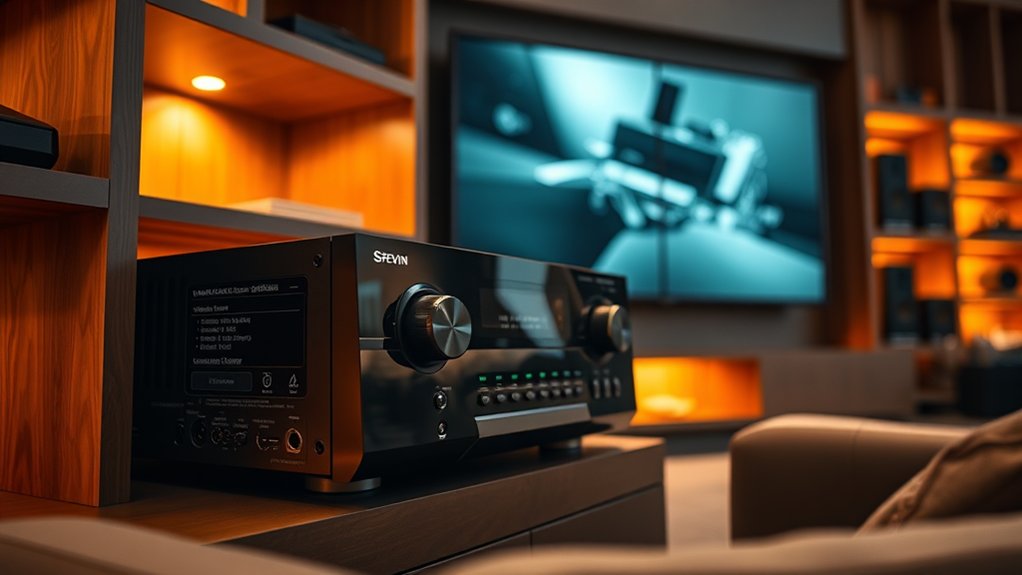
How can you improve your home theater experience without diving into the complexities of professional audio setup? One way is by checking for built-in calibration tools.
These handy features automatically adjust speaker levels, distances, and crossover frequencies, optimizing sound balance in your space. Imagine your home theater adapting to the room’s quirky acoustics, compensating for furniture and reflective surfaces as if it has a mind of its own!
Most systems utilize room measurement microphones and real-time digital signal processing for precise adjustments. It’s like having an audio technician on standby, minus the hefty fee.
Although not as granular as specialized software, these tools are usually perfect for residential setups, saving you time and ensuring a superb audio experience with minimal fuss.
Ensure Adequate Subwoofer Power
Guaranteeing adequate subwoofer power is crucial for achieving that deep, rumbling bass you crave in your home theater.
First, consider the RMS power rating, which indicates how much continuous power your subwoofer can handle without a meltdown (but hopefully not literally). Aligning your amplifier’s RMS output with your subwoofer’s rating prevents distortion and guarantees you’re not under or overloading it. Think of your subwoofer like a car engine—it needs the right fuel to run smoothly.
Remember to check the impedance as well; matching the ohms between your sub and amplifier allows for efficient power delivery. Whether you wire in series or parallel, keeping power loss to a minimum is key. After all, who doesn’t want bass that shakes the walls, not your budget? The 10-inch subwoofer from the Klipsch Reference Cinema significantly enhances audio performance, making it an excellent consideration for your setup.
Explore Aesthetic Compatibility With Your Space
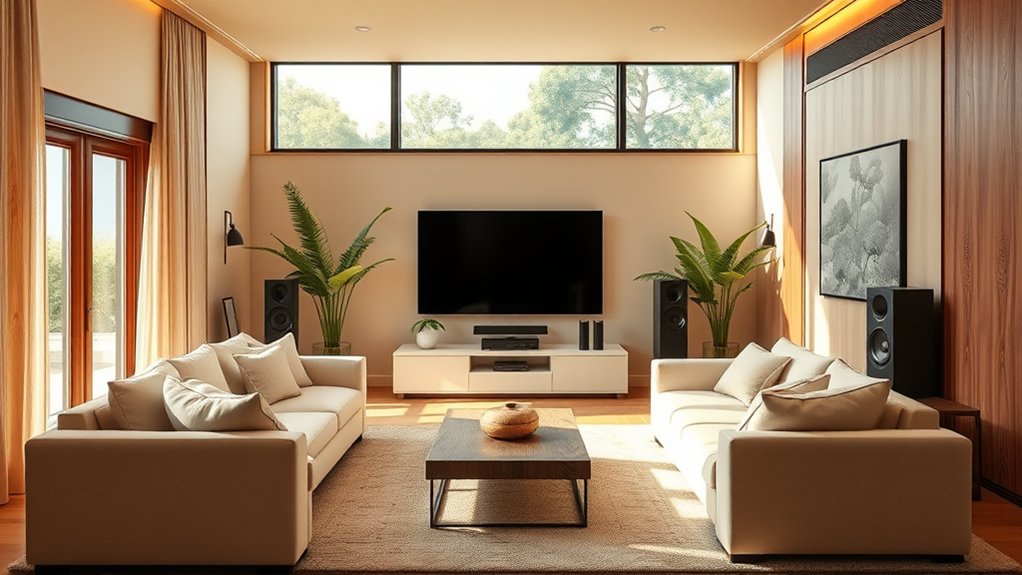
When you’re setting up your home theater, it’s essential to think about how every element—from color to seating—works together to create an inviting and cohesive space. Choosing darker wall colors, like Sherwin-Williams “Tricorn Black,” minimizes light reflections and improves your viewing experience, as well as contributing to an aesthetically pleasing atmosphere.
You’ll want your theater to blend flawlessly with your home’s overall design. Imagine mismatched bright pink chairs in a sleek, modern space—definitely a conversation starter, but not in a good way!
Use coordinated colors and materials for your seating and décor; this approach not only supports style but reinforces viewer comfort. A well-thought-out aesthetic can transform your home theater into a stylish escape, merging function with elegance.
Budget Wisely for Long-Term Value
Budgeting wisely for your home theater isn’t just about pinching pennies; it’s about maximizing long-term value. Start by considering the average installation cost, which ranges from $10,000 to $60,000.
Investing in quality equipment is essential—don’t get wooed by flashy features that mightn’t last. A solid stereo system or Dolby Atmos setup can significantly improve your experience and ensure superior audio performance.
Investing in quality audio equipment is crucial; prioritize durability over flashy features for an enhanced home theater experience.
Remember, good cabling and installation can add extra costs, but they’re worth it for durability and performance. It’s tempting to splurge on that top-of-the-line TV, but will it fit your space? Balance is key.
Plan for gradual upgrades instead of going all out at once, ensuring you don’t break the bank during the process of making your dream theater a reality.
Frequently Asked Questions
What Should I Consider for Outdoor Home Theater Setups?
For outdoor home theater setups, consider projector brightness, sound system power, reliable power sources, and weather-resistant screens. Choose a sheltered location and arrange seating to optimize viewing angles and audio experience for your audience.
How Can Room Acoustics Impact Sound Quality?
Room acoustics greatly affect sound quality by influencing clarity and balance. You’ll notice that room shape, materials, and speaker placement can improve or distort audio, making it essential to evaluate these factors for ideal listening experiences.
Are There Portable Home Theater Options Available?
Yes, you’ve got several portable home theater options available, like compact soundbars and mini projectors. These systems offer wireless connectivity and easy setup, perfect for enjoying cinematic experiences wherever you want without complex installation.
How Often Should I Update My Home Theater System?
You should consider updating your home theater system every 5 to 10 years, especially when you notice decreased sound quality, connectivity issues, or want to take advantage of newer technology and features for an improved experience.
What Accessories Enhance the Home Theater Experience?
To improve your home theater experience, consider adding high-quality speakers, an AV receiver, acoustic panels, luxurious seating, and proper lighting controls. These accessories greatly enhance sound quality, visuals, and overall comfort during your entertainment sessions.

